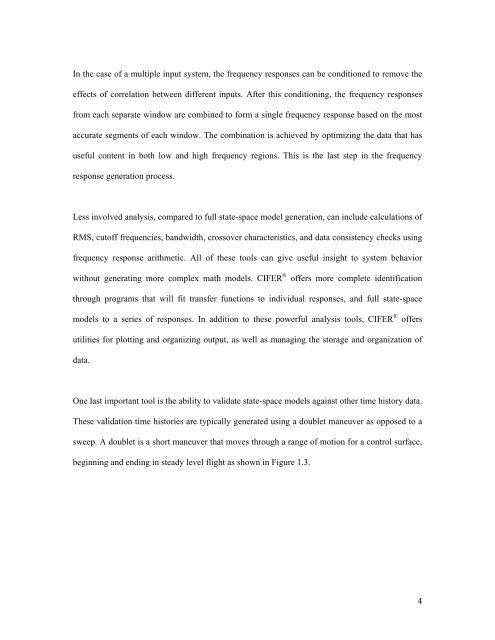CIFER®-MATLAB Interfaces: Development and ... - Cal Poly
CIFER®-MATLAB Interfaces: Development and ... - Cal Poly
CIFER®-MATLAB Interfaces: Development and ... - Cal Poly
Create successful ePaper yourself
Turn your PDF publications into a flip-book with our unique Google optimized e-Paper software.
In the case of a multiple input system, the frequency responses can be conditioned to remove the<br />
effects of correlation between different inputs. After this conditioning, the frequency responses<br />
from each separate window are combined to form a single frequency response based on the most<br />
accurate segments of each window. The combination is achieved by optimizing the data that has<br />
useful content in both low <strong>and</strong> high frequency regions. This is the last step in the frequency<br />
response generation process.<br />
Less involved analysis, compared to full state-space model generation, can include calculations of<br />
RMS, cutoff frequencies, b<strong>and</strong>width, crossover characteristics, <strong>and</strong> data consistency checks using<br />
frequency response arithmetic. All of these tools can give useful insight to system behavior<br />
without generating more complex math models. CIFER ® offers more complete identification<br />
through programs that will fit transfer functions to individual responses, <strong>and</strong> full state-space<br />
models to a series of responses. In addition to these powerful analysis tools, CIFER ® offers<br />
utilities for plotting <strong>and</strong> organizing output, as well as managing the storage <strong>and</strong> organization of<br />
data.<br />
One last important tool is the ability to validate state-space models against other time history data.<br />
These validation time histories are typically generated using a doublet maneuver as opposed to a<br />
sweep. A doublet is a short maneuver that moves through a range of motion for a control surface,<br />
beginning <strong>and</strong> ending in steady level flight as shown in Figure 1.3.<br />
4













